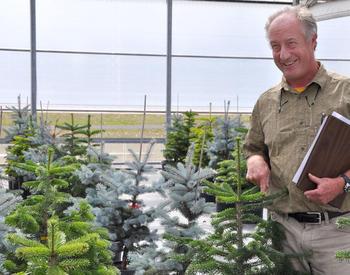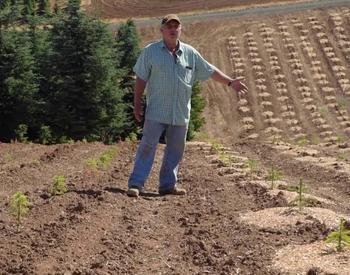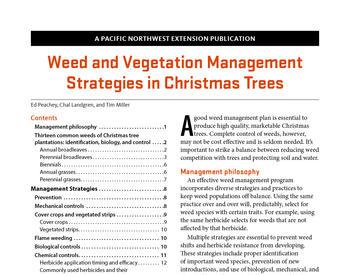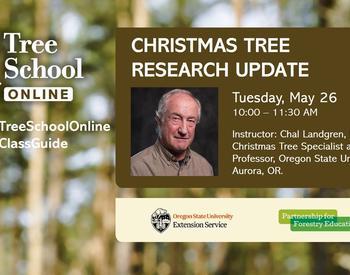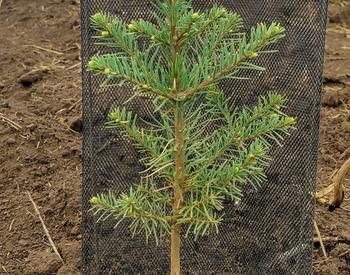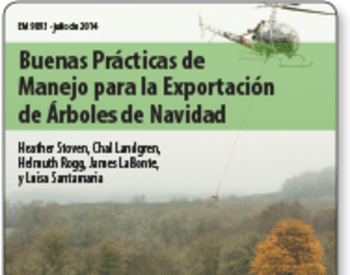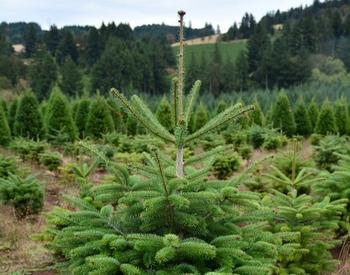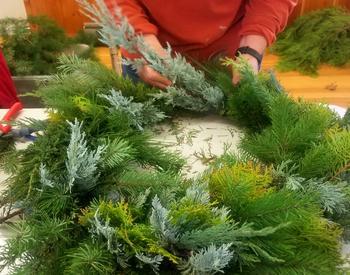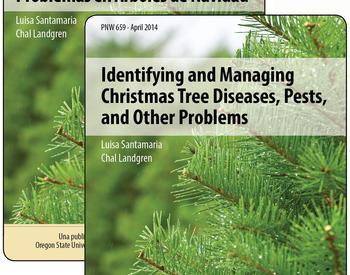Trying to control leader length on true fir Christmas trees (mainly noble and Nordmann) has been an obsession for me. Over the years, I’ve experimented with different trimming time periods; cutting to different bud types; and using tubes, sticks, clasps and various chemical treatments including herbicides and plant growth regulators. Some of these worked, many did not. And even when a treatment “works,” no treatment works identically across a field.
Our typical cultural practice for controlling top growth consists of trimming off excessive growth during the summer/fall when the sides are sheared. If the leader's next growth season is straight and leader-like, then success! But often the new growth is more like a semi-straight branch. A percentage of these “leaders” also need to be forced into vertical shape with time-consuming splints and ties.
In Europe, cutting leaders is not widely accepted, so growth control is usually achieved with plant growth regulators or scarring or some combination of the two. During trips to Europe and in living in Denmark for a time, I’ve been intrigued by both techniques and how they may be applied in a Pacific Northwest production system. The easier of the two systems has been the development of plant growth regulators applied to the growing leader.
I and others have been working for over 20 years looking at various combinations of naphthalene acetic acid, surfactants and other compounds. The naphthalene acetic acid program worked, at best, modestly well, but damage was a bit hard to predict and growth was variable.
Danish inventor Steen Sorensen began experimenting with S-abscisic acid as a growth regulator. With the correct rate and timing, it worked well on Nordmann fir. Exactly why and how it does the job is still a bit of a mystery.
Subsequently, I started trials in Oregon using a powdered form of S-abscisic acid. Over two years, we used the liquid formulation now named ConShapeTM SL, a product of Valent BioSciences. The trials have been supported by Valent and the Christmas Tree Promotion Board with tests on Nordmann, Turkish and noble firs at three sites in Oregon.
ConShapeTM SL has been approved by the EPA (Reg. No. 73049-493) and the Departments of Agriculture in Oregon and Washington for use on Christmas trees.
Here is a brief primer on how to use the new product
Species tested
Noble, Nordmann and Turkish firs.
How to apply
The best method is using an EasyRoller (figure 1). These are available from Drakes Crossing Nursery (503.873.4932) and consist of a tank with a pump attached to two paint rollers saturated with the plant growth regulator mix. The saturated roller is placed at the base of the leader and moved upward (figure 2) in one continuous movement, keeping the leader in the center of the rollers. Do not do multiple applications — one swipe with the EasyRoller is enough for coverage. Two swipes invite damage.
Why do this anyway?
Success with plant growth regulators means you don’t need to cut many tops, which means fewer splints and time-consuming top work. Also, success means you have intact terminal buds for next year and higher bud density along the shorter leader (figure 3).
When to apply
This is determined by the tree. The product works by slowing/stopping the leader growth. Typically, growers would use ConShape when the tree reaches 4–5 feet in height and the leaders would typically need to be cut. A general rule would be to apply ConShape when the leader is within 2 or 3 inches of the desired final height. So, if your desired leader length is 14 inches, apply ConShape when the leader is 11 or 12 inches. Keep in mind, no treatment works the same on every tree in the row.
What dilution to use
A safe first-time application would be to use the 20,000 PPM rate for the noble, Nordmann and Turkish firs. If you have a noble fir on a very productive site, the rate can be increased to 30,000 PPM. Do not add any surfactant.
What to expect
One liter (or one quart) of mix will treat around 1,300 trees at a rate of six trees per minute (depending on tree size, spacing, etc.). Only around 30% of the trees will be “ready” to treat on a given day. If you wish to return to the same area within a week, mark the treated trees so they don’t get a double dose. Growers have tried many ways to mark treated trees — flagging tape, bread bag clips, painting the ground or mixing a dye into the solution.
If you return after two weeks, there is little damage from a repeat dose.
What does the damage look like?
You are likely to see some trees with red needles, or even streaks of red needles (figure 4). At the suggested rates there should be little damage. At higher rates or double treatments on the same day, some leaders will be shrunken with dead terminal buds.
¡Use los pesticidas con seguridad!
- Póngase ropa de protección y equipo de seguridad según las recomendaciones de la etiqueta. Báñese después de cada uso.
- Lea la etiqueta del pesticida—aunque lo haya usado antes. Siga al pie de la letra las indicaciones de la etiqueta (y cualquiera otra indicación que Ud. tenga).
- Tenga precaución al aplicar los pesticidas. Conozca su responsabilidad legal como aplicador de pesticidas. Usted puede ser responsable de heridas o daños resultantes del uso de un pesticida.




